The most (and least) dog-friendly countries in Europe
Since leaving the states to travel full-time, Luna the traveling pooch has been to 22 European countries (and 26 countries overall).
Now, we still have plenty of Europe left to explore, but since we’ve been to so many places, I thought it might be useful to my fellow with-dog travelers if we did a bit of comparing and contrasting. Because some countries are definitely easier to navigate as a with-dog traveler than others, and it’s never a bad thing to know ahead of time what to expect.
Below, I’ve ranked every European country we’ve gone to on a scale of one to five (along with an explanation of why I’ve chosen each ranking).
One is the lowest pet-friendliness. It reflects a place where I not only had trouble getting around or finding accommodations, but actually felt unwelcome or unsafe with my dog.
Two is below average pet-friendliness. Keep in mind that I’m using a European average. Not a US average. If the US were a European country, I’d give it a two overall (though some towns are certainly better than others). In general, dogs are allowed in a very limited number of spaces in the states, and public transit (especially long-distance transit like trains) usually does not allow dogs, which makes the US tricky to navigate with pooch in tow.

Three is the average for Europe (which means at least some restaurants welcome pets, you can get around with your pet and without a car, and the general feeling about dogs is positive).
Four is exceptional. These are countries where you can take your dog almost anywhere. Take them to brunch or out for coffee. Take them to pretty much any park in any city. Take them on buses, trains, and in cabs. Find hotels easily. Your life will not be particularly tricky traveling with a dog in these countries.
And five means dogs have near-human status. The only place you probably won’t see them is the grocery store.
So, based on our experiences in the last six years, which European countries are the most dog-friendly…and which are the least?
Here’s the ranking, with countries listed in alphabetical order. (Again, remember, this is based on our personal experiences; others may feel differently about some of these.)

Waterfalls near Konjic, Bosnia and Herzegovina.
Austria
Ranking: 4
Reasoning: I haven’t spent as much time in Austria as I have in some other European countries (probably a cumulative five weeks over the last few years), but when Luna and I passed through Salzburg, Innsbruck, and Villach, we found each to be overwhelmingly pet-friendly. We were allowed in most restaurants and cafes without issue. Trains are pet-friendly. People were always happy to see Luna. Finding accommodations was always easy. And the only places Luna couldn’t go were grocery stores and perhaps some churches or museums.
Belgium
Ranking: 4
Reasoning: With several months of our lives invested in Ghent, Bruges, Antwerp, and the surrounding areas, Luna and I rarely ever encountered a place she couldn’t go. Finding accommodation was easy. Transportation was easy.People loved her and cute little grandmas would coo at her at the bus stops all the time. And the only places I didn’t take her were grocery stores, Asian restaurants (which generally don’t welcome dogs anywhere in Europe), and churches.
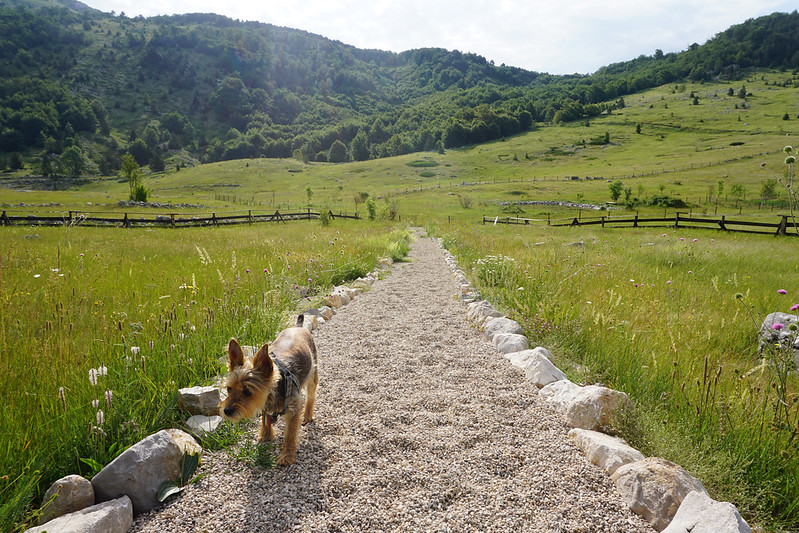
The mountains above Mostar.
Bosnia & Herzegovina
Ranking: 1
Reasoning: While it was easy finding a good rental that would take Luna and we didn’t have any trouble with the taxis we took across the country, we did run into some major cultural barriers to with-dog travel.
The biggest is that while there is a large group of locals who love dogs, there’s also a large group of locals/tourists that hate them. And I don’t mean they walk by and mind their own business hating dogs. I mean they would kick at Luna or jump away from her in an exaggerated manner or stomp their feet to scare her as we passed.
We also had trouble with transit (no one seemed to know if dogs were allowed on trains or buses, including the people who worked for said trains and buses, so we were told yes, she could go on the train, but then denied entry when we arrived).
Vets here are very nice and well-trained, but have limited access to facilities and medications in case of emergency, and the large group of people who were aggressive toward Luna during our stay (which was scary several times) is really what ranks this country so low for us.
Croatia
Ranking: 2.5
Reasoning: Finding accommodations was easy and we saw plenty of happy, healthy dogs out walking with their owners everywhere. We worked with excellent vets when Luna got horribly ill (this is where she got pancreatitis) and they were wonderfully affordable. And I’d say restaurants and cafes were about 50/50. Some allowed dogs; others didn’t.
The reason I’ve ranked this a little below average is the transportation. Train transit was fine, but in Croatia trains are limited. And the bus systems typically leave it up to individual drivers whether they want to take a dog. Sometimes this is fine (Luna and I took a bus from Split to Rovinj no problem) and other times it means the bus driver says nope and you’re stranded (which happened to us in Dubrovnik). This makes Croatia a tiny bit more of a hassle than your typical European country, though I’d still recommend it (just keep the transit challenges in mind).
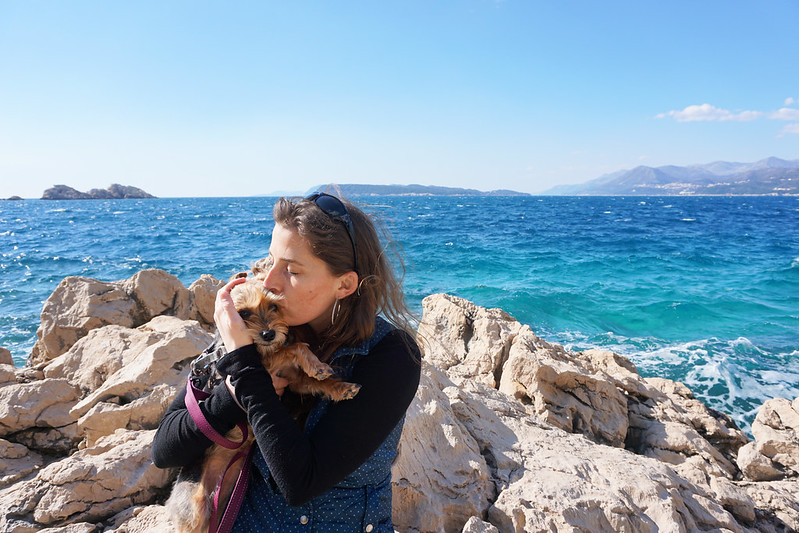
Dubrovnik, Croatia.
Czechia
Ranking: 2
Reasoning: I wish I could rank Czechia higher. Restaurants were dog-friendly (we even took Luna on a food tour) and transit was no problem. We found our apartment easily. And hiking with Luna in the national park up north was a joy.
BUT we also encountered some alarming xenophobia in Prague that included vet offices that refused to treat dogs for people who didn’t speak Czech. Heaven forbid, if Luna were in some sort of dire accident, I do not want to chance being in a place where she might be denied care just because I don’t fluently speak 20 languages. That’s absolutely unacceptable to me
Estonia
Ranking: 4
Reasoning: Dogs are welcome almost everywhere in Estonia. Dog-friendly hotels were easy to find, as were dog-friendly apartment rentals. Hiking trails, beaches, and shops – all dog-friendly. And trains, trams, and buses were mostly dog-friendly (signs indicate that dogs should be muzzled on trams and we took Luna on trains and buses in an open carrier).
The one exception to the generally dog-friendly transportation are cross-border buses, which did not allow dogs (you can get around this by either taking the train or taking a bus to the border, crossing on foot, and taking another bus). The only other place I saw no-dogs signs was on the main beach in Parnu.
France
Ranking: 3
Reasoning: France is my perfect average. Dogs are welcome in many restaurants and cafes. We were never bothered when we took Luna to fresh markets. Transportation was easy to navigate. And rentals were very easy to come by.
Some parks (especially in Rennes and Paris) are not dog-friendly (which is always baffling to me), but overall you’ll find France very easy to navigate with a dog.
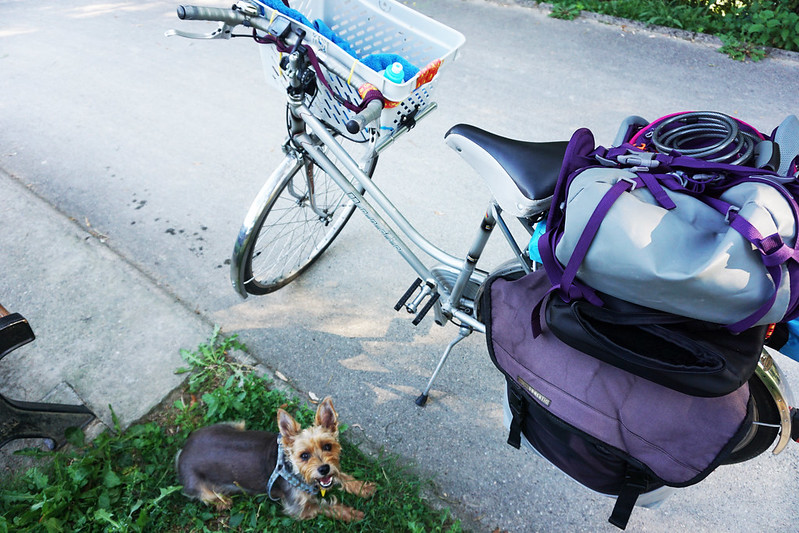
Cycling across France.
Germany
Ranking: 3
Reasoning: In general, dog-friendly accommodations, restaurants, and transit are easy to come by. Locals tend to keep to themselves, but the culture is overall welcoming to dogs.
Hungary
Ranking: 2.5
Reasoning: In general, we found Luna was welcome pretty much everywhere we went, including on our food tour (and in all the restaurants and cafes on the tour). Finding a hotel in Budapest was easy. We did run into a no-dogs sign at the fresh market, but nobody said a thing to us when I carried her through.
The only tricky thing was transit. The Hungarian train rules are a bit confusing (no dogs on any train or car that requires seat assignments according to the website, but that could mean several things), and we kind of crossed our fingers and decided to ask forgiveness rather than permission. Luna’s pretty quiet in her carrier and no one asked about her, but I’m honestly still not entirely clear on which trains she technically was and wasn’t allowed on.
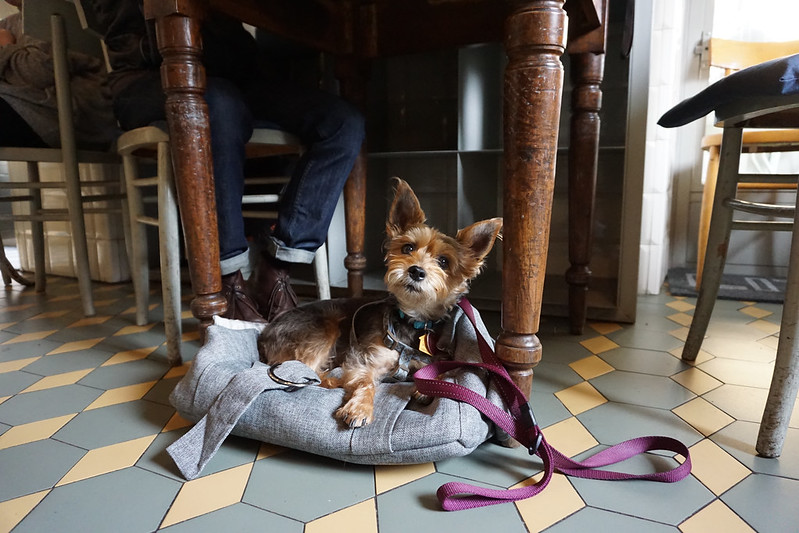
A restaurant in Rome, Italy.
Italy
Ranking: 4.5
Reasoning: Accommodations, trains, stores, restaurants…it’s all so easy to navigate with a dog in Italy! Not to mention that locals have loved her pretty much everywhere we’ve gone – from Modena to Rome to Sicily. Occasionally you’ll run into something that isn’t dog-friendly, but it’s extremely occasional and Italian culture is extremely forgiving, so nobody’s going to hunt you down to yell at you if you’ve wandered into a no-dogs-allowed covered market. We even saw dogs in grocery stores in Florence, so seems like there’s very little off-limits to dogs.
Latvia
Ranking: 4.5
Reasoning: I was pleasantly surprised to find that Latvia is one of the most dog-friendly countries we’ve been to in Europe. In my 10 days of walking the coast from Riga to the Estonian border, I only saw one beach with a no-dogs-allowed sign. Trails were dog-friendly. Hotels with good pet policies were easy to find. Restaurants rushed to bring dog bowls full of water over to the table. I even carried her into several rural grocery stores while we were hiking and nobody cared.
Lithuania
Ranking: 4
Reasoning: Our stay in Lithuania was very brief (just a long weekend in Vilnius), but the experience was very positive. We had no trouble finding dog-friendly accommodations. We took Luna into several restaurants without incident (and saw other dogs there as well). And we were thrilled at all the parkland/green areas to walk her in throughout the parts of the city we explored.

Naps in Opatija, Croatia.
Malta
Ranking: 3
Reasoning: Dog-friendly apartments were easy to find. Hotels were a bit trickier, but we were also there in winter and not as much was open, so summertime might be a much easier task. Transit was also easy (buses never blinked an eye at us). The lovely hiking trails were all dog-friendly. And I took Luna into many restaurants without issue.
The one thing that does make Malta a little trickier is its location (an island south of Italy), which means to get there you’ll need to fly (and the maximum size allowance I’ve been able to find in cabin for Malta is 20 lbs, so any bigger dogs will have to brave cargo). You’ll also need a special vet visit to get Malta health approval in your pet passport a few days before travel (and then another health certificate to leave).
Montenegro
Ranking: 2.5
Reasoning: Montenegro is similar to Croatia. Which means the trickiest thing here is transportation. People seemed amazed and somewhat uncomfortable when we took her in taxis or cars. And for buses, it’s always up to the bus driver whether you can board with your dog. The first time we took a bus, they didn’t even glance at her. The second time, the driver seemed very unhappy about it, but eventually decided to let us board instead of waiting for the next bus.
Technically, dogs aren’t allowed indoors at restaurants, but you’ll generally find them welcome on patios and occasionally you might find an indoor space that looks the other way.
We also got the sense that pet dogs were a little rarer here than in other parts of Europe. There were a lot of big, loud guard dogs chained up in people’s yards (and sometimes not chained, so do keep an eye out and whisk your small dog up into your arms as needed) and we were ambushed once by a dog that appeared to be trying to bite Luna (Chad ended up chasing the dog down the block shouting while I grabbed Luna and lifted her into my arms in the nick of time).
So, overall I would recommend Montenegro to with-dog travelers, but don’t expect it to be as dog-friendly as the rest of Europe and do keep an eye out for potential aggressive dogs.
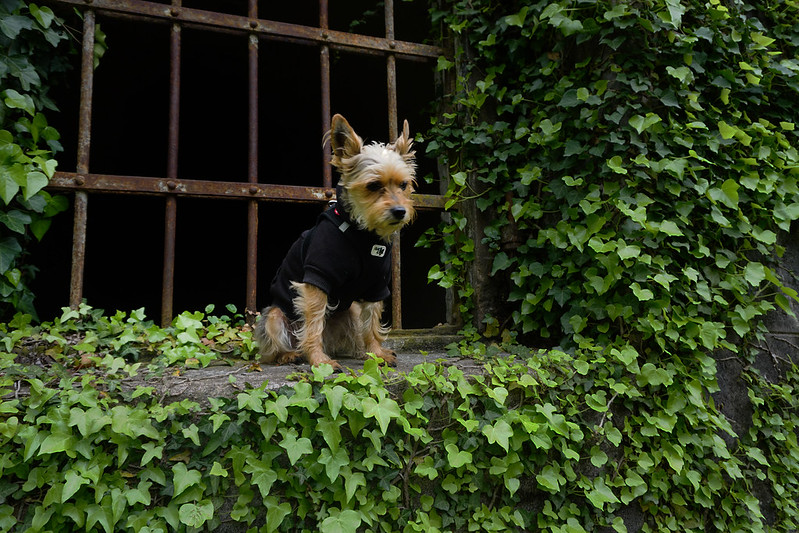
Exploring an abandoned fortress in Montenegro above Kotor.
Netherlands
Ranking: 3
Reasoning: I only spent a couple weeks in the Netherlands, so take this one with a grain of salt. It might actually be a 4 on my scale. Accommodations and transit were super easy with Luna, but navigating the exceptionally busy streets of Amsterdam was a challenge just because of how many people and bikes were everywhere.
Portugal
Ranking: 2.5
Reasoning: Unlike much of Europe, sadly Portugal often does not allow dogs indoors in restaurants, cafes, etc. It’s very much a case-by-case basis and you may find yourself without an indoor eating option on a rainy or cold day. That said, Portugal tends to be sunny and warm and dogs are generally welcome on patios and balconies.
Transportation here is also a bit hit or miss. Trains are dog-friendly (with your dog in a carrier), as are city buses and metros. But distance buses vary, which can leave you in quite a pickle if you don’t plan ahead. Similarly, I’ve found that accommodations are harder to find here with a pet when compared to the rest of Europe. So while I have chosen to live in this country, I would say it is a little less pet-friendly than the average European locale.
Romania
Ranking: 2
Reasoning: Romanians love dogs. Train travel was simple. Local buses didn’t bat an eye at us. Our vet was great. And finding apartment rentals was easy.
We did have trouble finding hotels (honestly, the most trouble I’ve had anywhere in Europe), so that pushes it a bit below average, and the vast majority of restaurants and cafes in Brasov were not dog-friendly, so expect to eat on patios or leave your pooch behind.

Lake Bled, Slovenia.
Slovenia
Ranking: 4.5
Reasoning: Slovenia is the most dog-friendly place I’ve ever been. I had no trouble finding accommodations, taking Luna into restaurants, cafes, and stores, or taking trains all over the country. They even let me take her in a church! (Which is pretty much unheard-of anywhere else in Europe.)
I did have one bus driver tell me they normally don’t take dogs, but no one else ever said anything and even that bus driver told me I could stay on anyway.
Spain
Ranking: 2
Reasoning: Finding accommodations was pretty easy, but I encountered a lot of no-dogs signs on restaurants, stores, and cafes and the bus systems in Spain are generally unfriendly to dogs. We were forced to take a car service along the coast because no one would transport Luna via bus and there was no train option. It’s also worth keeping in mind that there’s a very toxic caterpillar in the south, so it’s worth researching times of year to visit and avoid that little guy.
I didn’t feel unsafe with Luna in Spain overall, but it’s a much bigger hassle to travel there with a dog than it is in most parts of Europe.
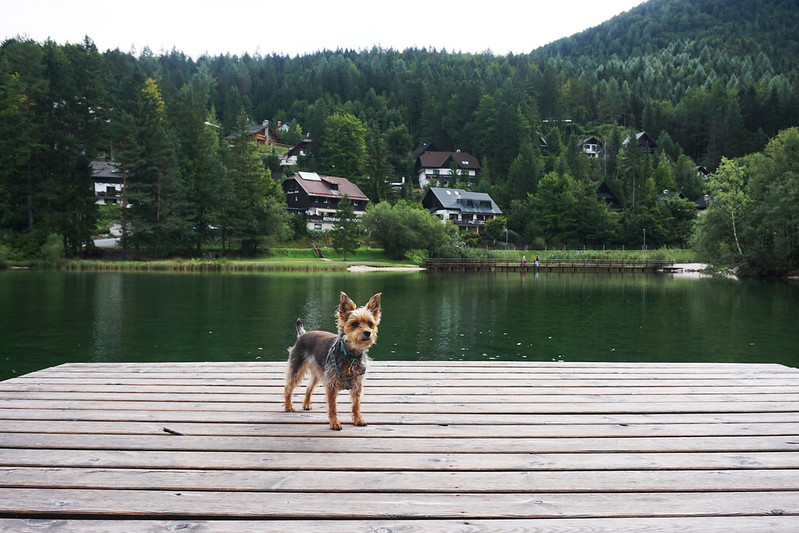
Lake Jasna, Slovenia.
Switzerland
Ranking: 4
Reasoning: Transit is pet-friendly. Hotels and apartments are easy to come by. Restaurants and cafes are usually fine with dogs. I don’t think I’ve ever seen a No Dogs Allowed sign on a public park. And take a dog to the pub and you’ll be the most popular person around. The only places you won’t see pets are grocery stores, Asian restaurants, and maybe churches.
United Kingdom
Ranking: 2.5
Reasoning: Ever so slightly more dog-friendly than the US, the UK is good with transportation (trains take dogs, no problem) and dogs are often allowed in pubs. However, I did have a tricky time finding accommodations for a with-dog traveler in a reasonable price range (it’s an expensive place and a lot of the budget options were no-dogs). Getting to the UK is also tricky (only ESAs and guide dogs can fly in-cabin on the airlines, there are no pets on the Eurostar, and only a select few ferries allow dogs). And it mirrors the US in that restaurants do not allow dogs inside. So expect it to be a tiny bit easier than traveling within the US with a dog, but not by much.
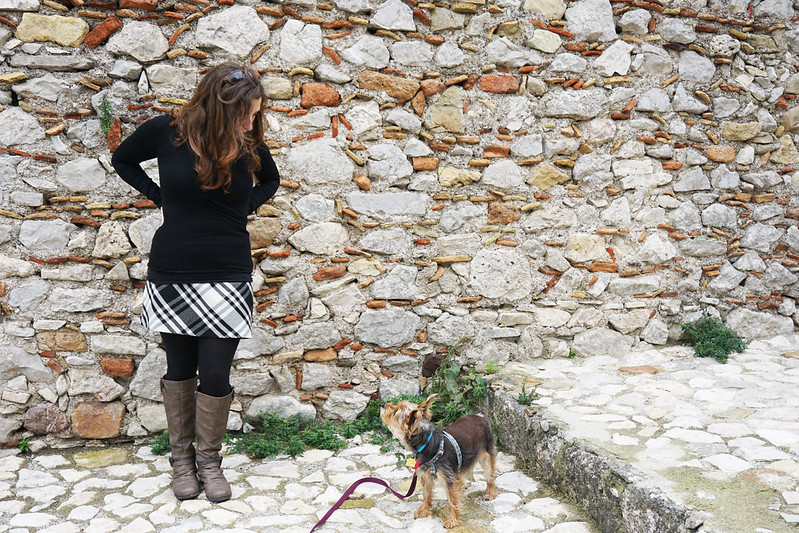
In a fortress above Taormina, Sicily, Italy.

Hiking in the rain in Plitvice Lakes, Croatia.
Now, to you: What have your experiences been like across Europe? Which countries feel particularly dog-friendly to you?
Comments
-
-
Paula Elliott
We traveled all over Switzerland while living there with our dog. Dogs are strictly forbidden on playgrounds! Which means you can take them to most parks but even if there’s no sign, it is considered to be a big “DUH”. I got Swissed by a man for approaching an empty playground in our neighborhood with my Welsh Terrier. (We expats use the term for when a Swiss would shake their finger at us or shame us for something like mowing on Sunday or boarding a bus with a coffee LOL)
-
-
Ali
Aw I would’ve thought 4 for Germany. Obviously I don’t have a dog so I can’t compare, but everywhere is so dog friendly (including the Asia restaurants we frequent) & there are dogs at every park I’ve seen. Tempelhof, the park that used to be an airport, has 3 huge off-leash sections. Because it’s Germany, people take their dog training super seriously, so they don’t like you to just pet their dog without asking…I’ve been yelled at for that before! But it’s so cute to watch the dogs run ahead of their owners (because they’re almost all so well behaved off leash) and then stop at an intersection because they know not to cross the street alone.
-
Joy Thierry Llewellyn
What an interesting overview. As always, your blogs are a pleasure to read. As to France not allowing dogs in parks, I’m surprised you’re surprised. Having lived in France on several occasions, I quickly learned it’s a country that does not believe in picking up after their dogs so the plops of dog droppings are everywhere. How nice to know you could go into a park and sit down and not regret it. Wishing you continued adventures with Luna, and thanks for sharing them with us.
-
Pamela
Great list! But I’m curious if you observed any differences between the way large dogs were treated compared to small dogs. Even in the US, small dogs are welcomed in more places than large dogs.
For example, I researched pet friendly public transit in the US and Canada and found a surprisingly number of systems allowed small dogs. But only a few allowed large dogs. https://blog.gopetfriendly.com/pet-friendly-public-transportation-us-canada/
-
Irina
USA hates dogs. I live here, my dog is a service dog, we have really hard time to enter restaurants/coffeeshops/parks and beauty salons except of they are expensive. Ppl are annoying as f.ck, every single person have to chase me and ask why my dog is not on a leash ( and my dog is small and trained to behave) as soon as they see service dog vest, they shut up, but not always. Very annoying. Ppl in US don’t understand what companion means, they all seeing pets as toy 🙁 IMHO
-
Louise Karisny
Which states? I live in the south and have also traveled throughout the United States as a US citizen . I find that people are very welcoming of my small dog , little 3 pound Yorkie..
-
Yana
such a not true statement, maybe depends which state, we are in CA, and I travel with my service dog (small) everywhere in US. You just have to tell them this is a service dog. With not service dog if restaurant has outside sat you can bring dog in and some restaurants have a dog menu.
-
-
-
Hanna
I found this blog when I was googling “dog friendly restaurants in Spain”. I read your post about Spain and I got worried. I’m going to Spain next week with my italian greyhound. I have a car, so it’s easy to navigate but we live in South of France where dogs are like human. They are accepted everywhere. So I’m thinking where I can have lunch or dinner in Spain..huh.. I really hope that I find some normal places where to go and grab something. That’s funny that dogs are not allowed in lot of places…
I have travelled with my dog from Finland to France and I must say that I really like Polish pet friendly hotels. They are cheap but are highly rated and they accept dogs (sometimes 4/5* hotels don’t accept dogs).As I travel often with my dog I have a question for you. Have you ever been worried that somebody can kidnap your dog?
I even don’t like to leave my dog in the car while I’m in the gas station…
I’ll bookmark your blog, it’s interesting 🙂 -
Elina
This is such a helpful list, thank you so much! We temporarily live in Turkey and have been with our puppy Osi (German Spitz, 13 lbs) to 8 countries thus far – US, Turkey, France, Italy, Russia, Spain, Austria and El Salvador. Turkey is surprisingly pet friendly, especially in more culturally Western areas. In addition to Italy, Russia (at least Moscow) would be at the top of my list — small dogs can go to most restaurants, even fancy ones, and no problem on any transportation. Moscovites also went goo goo ga ga over Osi because he looks like a little chocolate bear 🙂
-
Rosemary
Oh my! Kicking and stomping at a dog! That must have been scary for you and Luna.
Thing is if someone did that to one of my dogs, it would mean raised heckles and probably a growl – from me! So won’t be going near Bosnia & Herzegovina anytime soon.
Shocking that some vets in Czechia refuse to treat dogs if the owners don’t speak Czech! Rude and totally unprofessional.
I would have thought the UK would have scored higher, having spent a lot of time living there (although more in the countryside and many years ago) I always thought they were a super dog-friendly place. Pity they don’t make it traveling to the UK easier for with-dog folks.
-
Melissa
We’ve been traveling Europe with our two Yorkipoos since January 1. This post is so helpful! We only did a drive-by, really, through Spain with a week in Madrid and a few days in Barcelona, but we loved it. After weeks of being denied entrance to restaurants in Lisbon, Spain was a delight. Google SrPerro and it will take you to a website where you can find dog-friendly establishments. We actually ate a multi-course meal in a Michelin-rated restaurant with our pups on our laps. That was a first for us!
We’ve also had better luck in Croatia (where we are now). They’ve been welcome inside almost every restaurant with us.
We do miss Italy, though, which was much easier. I’m now feeling more excited about our next travels after reading this. Thanks! -
Kyra Rodriguez
I love traveling with my dog. We literally always look for hotels or Airbnb that is pet-friendly. Anyway, thanks for listing these all down!
-
Martine
Having just spent 2 weeks in Slovenia (without my dog), my observations would confirm your positive high rating. I saw well cared for dogs everywhere. Never saw any random homeless dogs, never saw poop anywhere. Dogs were going on the Vogel gondola for hiking – they were required to wear a muzzle while on the gondola, which I say is fair. Slovenia is a gem. Wayyyyy better than Croatia.
-
Danielle
I can definitely agree that Germany is a pretty dog-friendly country unless you are going with a “dangerous breed”. I live here in Germany with my Rottweiler and the regulations are extremely strict and if you want to travel here you will have to do some proper research on which dog breeds you can bring here.
-
Dino
Found your blog randomly! Sorry you had such a bad experience with the dog in my home country of Bosnia and Herzegovina. A lot of dogs you encounter “on the street” in BiH are strays, have a stigma of being dirty, and some Bosnians with intellects not much greater than said animals have learned to deal with them by scaring them. Even those strays are often reasonably well behaved, but Luna seems like an absolute pleasure <3
Wish you all the best in your travels and greetings from a Mostarian
-
Tis
Thanks for a great and very useful post!
Here’s what I’ve learned during time spent in Finland and Sweden: they’re dog friendly BUT overall relatively strict due to legal restrictions regarding pets in public spaces and what I’d call a generally law abiding mentality.
By this I mean that the general attitude towards dogs is positive and I’ve never encountered scary or abusive behaviour, but there are lots of rules and you shouldn’t expect them to be overlooked or bent much. If you proceed from the idea that you’re in a place where people both really like dogs AND are very safety minded AND are considerate of others who may have allergies or fears AND the standard of hygiene is high, you’ll have a pretty clear working concept of what will be allowed and what might be a problem.
On the other hand, information is usually available and clearly posted. Dogs aren’t allowed inside most restaurants, but seem to be generally welcome on outside patios (which only helps if you’re there during the summer months). In Helsinki, I’ve seen restaurants, pubs and cafés that do allow dogs inside provided they’re well behaved, other customers don’t complain, and in some cases, they may be limited to specific tables near the entrance.
Dogs are allowed in public transport, but often only in specific pet spaces or carriages and at least in Finland there’s an extra charge on trains. (I did find it stressful in the Stockholm underground that I had to run around on the crowded platform looking for the carriages with a dogs allowed sign on it…)
Dogs are always expected to be leashed within city limits, including in parks and other nature areas, and you’re expected to clean up after them (you’ll rarely find dog poop on the streets). They are not allowed on playgrounds, and outdoor museums seem to be generally off-limits too (such as Skansen in Stockholm). You may find tiny off-leash areas reserved for dogs in parks. (In Helsinki I even saw they had separate areas for large and small breeds, so there’s some extra safety mindedness for you!)
At least in Finland, dogs aren’t allowed on public beaches and in theory, not on public market places although the latter is recent a rule that some cities don’t enforce and dog owners aren’t always even aware of, and which I subsequently saw broken daily everywhere (including by me as I only heard about it afterwards, oops). Outside the cities on trails people may let their dogs off leash.
Dogs aren’t generally allowed inside public buildings such as museums, libraries and churches. In shops and shopping centres, look for signage at the front door. At the Finnish shopping centre I went to, I had no problem entering the non-food shops with my dog, although I got the impression it may have been a bit of a novelty for the staff (who then lavished my little buddy with cuddles and compliments).
The Viking ferry crossing between Sweden and Finland was quite pet friendly. There was an extra charge, but our dog was allowed in public areas (except shops, restaurants and such) and in the cabin. We were informed we could order our lunch at the restaurant and eat seated right outside it in the common area, where there were tables where pets were allowed. The waiter even brought a free plate of roast beef leftovers for my little buddy. As I said, strict but friendly!
I’d bet anything that getting medical help for your dog won’t be a problem; fluency in English is commonplace and animal welfare laws are as strict as all the other ones.
-
Vlad
It’s interesting to read about your experience of travelling with a dog. I expected the UK to have a better rating. I live in the UK and I feel like it’s a super dog friendly country. I am originally from Romania and I have travelled with my dogs around Europe. I prefer the UK to many other countries for dog-friendliness. I didn’t have to deal with the public transport with my dogs though, at least not yet as we are using a car (actually campervan now, to comfortably fit the pack) for travelling with our dogs. I also have to admit I don’t go to restaurants too much so I don’t really know how they typically handle dogs. I prefer pubs (I just feel more comfortable and welcome in a pub than a restaurant) and I’m yet to see one pub that won’t welcome dogs and have dog water bowls around and some even have dog food on the menu.
I find people generally being happy to see dogs, which is not the same experience I have in other EU countries (on average, there are awesome people everywhere). In some EU countries I have the experience of people getting a little scared or worry about dogs, especially when off-lead. In the UK people are mostly happy with dogs approaching them. Parks are full of people walking dogs.
As far as I know in Austria (and Luxembourg) you aren’t allowed to let your dog off-lead only in designated places. I did let my dogs run around in a park in Austria and I had the general feeling of people being really unhappy with me and my dogs being there. Had no problem going to restaurants though (seated outside).
In terms of travelling to and from the UK with a dog, I think it’s a pain unless you drive and take the Eurostar (you stay in the car with your pets) to/from mainland Europe. The ferry isn’t too bad either, but you have to leave your dogs alone in the car for transit which I don’t really like. When coming to the UK you need to make sure your dogs get the appropriate worming treatment 1-5 days before you cross the border.
-
Allison Tomlinson
Awesome post, thank you! I live with my 35 kilo dog in Spain, and my husband and I want to travel with him across Europe this summer. I would be interested to know the situation with dogs roaming or off leash in these countries. My dog has absolutely no interest in other dogs, other than big dogs scare him. If he is scared, his hair goes up, and his tail goes down. Some dogs don’t like him for this, so I worry about untrained, aggressive, and big dogs around without owners. Also, are the processionary catepillars not in other countries in Europe? Thank you again for the information.
-
Demi
Hi Gigi, I have a vehicle, so it’s anything but difficult to explore however we live in the South of France where mutts resemble people. They are acknowledged all over the place. So I’m figuring where I can eat or supper in Spain. I truly trust that I locate some ordinary spots were to proceed to snatch something. That is interesting that pooches are not permitted in a lot of spots.
-
Christie Wilson
I’m so glad I came upon this post! My fiancé and I may be moving to London in the next year and we’re just starting to explore what that will be like with our two dogs. We have a Golden Retriever and a mix breed that’s about 50 pounds. So they’re bigger than Luna. This post definitely opens my eyes to the possibilities with our pups. We love to travel and if we’re moving, there’s no way I can leave them here!
-
Richard Paolucci
Thank you for sharing Gigi about the most and least dog friendly countries in Europe. I would like to travel across Europe someday with my dog and your article is very interesting and useful to me. Nice pictures also. Your dog is very cute!
-
Ade O'Brien
I think when you get the hang of getting into the UK (tape worm tablet and driving or taking a walk on ferry) once you are here it is pretty easy. Dogs are welcome on all public transport, no need for carriers or muzzles, more or less all pubs (many of which are fine restaurants in their own right) and most non-food shops. Also there is no requirement to keep your dog on leads in parks so they can run around like mad and people love them here. Granted restaurants and food shops are a big no no which drops it down below Germany, Austria and Czechia for me.
Which brings me to Czechia! I think it is amazing for dogs there. I have not been barred from anywhere with my dog. I have also visited vets. Now it’s true that the vets have not spoken English but when I have made the effort to look up what my dog needs in Czech and speak or show it on my phone to the vet, they have been more than happy to help me and do what we need, and very friendly and loving to my dog. No, you cannot expect Czech vets to speak English but if you can bridge the language barrier, which is not so hard with online translators now, I have found them to be more than helpful. Definitely a 4 from me.
Greece is horrible. Much more like Bosnia in your report.
-
Rick Sutton
Awesome information here. Thank You. However I would like to twist the scenario just a bit and ask a question. Rather than specifically traveling with a pet (dog), my partner and I are considering Costa del Sol to settle down for retirement in 2-3 years. Our issues are finding an apartment that takes a dog (or two) of 60 lbs. Dogs (well behaved) are a huge pat of our lives. Costa del Sol is an area that we’ve spent some time researching, but would have to rule out if life there for them would not be a good one. We will always be renters there… having a car for our own transportation (with pets) is a possibility, but we’d rather be pedestrian/public transit. What do you think? Comments from anyone here are welcome.
-
Elizabeth Gustafson
Thank you for all the great information!
Luna is a beautiful silky terrier for sure.
Have you ever tried a puppy backpack to enter grocery store/market with Luna? -
Annely
I’m curious to hear which supermarket in Florence allowed dogs? I’ve just moved here and trying to find one 🙂
-
Erika
Thanks for this list – it’s super helpful. I live in the Netherlands and would definitely move it up to a solid 4 (or even 4.5) on your ranking system – I bring my dog EVERYWHERE with me! She’s been welcomed on trams, busses, trains, bikes, taxis, boat tours, she comes with me to hair cuts, pubs, restaurants, cafes, and even is welcome in my pilates studio. She has only been turned away from grocery stores and a few “open kitchen” restaurants. Dogs are king here and Amsterdam’s Vondelpark is entirely off leash – it’s doggie heaven.
I’d also rank Germany a 4 as we have never had a problem there. In fact, when visiting friends in Munich, we booked a day trip to Castle Neuschwanstein, and the guide not only allowed us to bring our FOUR dogs with us, she even stayed with them in the van to keep them warm and safe while we toured the castle.
Here’s a hint for future trips, when things are normal again: bring a dark-colored doggie backpack or bag carrier, if your dog will stay quiet and calm inside one. When we lived in Seoul (which would be a 0-1 on your scale) we learned that we could just discreetly pop our dog in the backpack, then tuck it under the table in restaurants so no one ever knew she was there. It’s also handy on public transit and in Ubers and taxis. This gives you a lot more options when traveling in less dog-friendly countries.
-
Iris
This. Netherlands is extremely dogfriendly and I have taken my dog to every place listed in the comment above without any trouble. The only places I can’t bring my dog is grocery stores and art museums. The touristy city centre of Amsterdam is definitely busy, but that’s like saying the US is not dog-friendly because Times Square too busy to safely walk your dog.
-
-
D
I wish I could find a guide like this on traveling with pitbull style dogs. I have a mutt that is lean like a shepherd, but with a more boxy Staffordshire face -so there is no hiding the “pitbull breed” part. I’ve been trying to find up-to-date info on traveling with him and it seems even some super friendly dog countries in Europe have crazy breed restrictions on my dog. (I can’t even travel through by car in some countries.). Many countries don’t have specific info and it seems up to the border if they let you through or not.
-
Clare
Thanks for this. It’s really difficult to find search results for “EU countries that are not dog-friendly”. One of the reasons I left Malta was all of the “evidence” of dogs on all of the sidewalks and paths, and now I’m in Spain, where there are trees, special-built grass mini-terraces, and designated dog parks and dog beaches, and dog owners still think it’s okay to let their dogs urinate and defecate on public walkways, buildings, rubbish bins, lampposts, benches, … I’m surprised Spain scored so low on your list, considering the tolerance this country shows for bad owners and the mess they leave behind. Maybe Croatia next….
-
Alayna
Do you find that your experience would have been even more difficult with a bigger dog? I have a lab mix who is slightly bigger than yours and I wonder if it’s harder to be allowed on trains and transport with a dog who can’t go into a carrier.
-
Joseph Huth
This article is very supportive of dog-owners. I used to love dogs but after living in a neighborhood in the US with several dogs barking constantly all day, I have had it. I am searching for an area of Europe that is more tolerant of it’s residents’ need for harmony, peace, and quiet than tolerant of irresponsible dog owners who let their dogs bark incessantly without any regard for their neighbors. Any suggestions?
-
Irina
Thank you for this. Was considering going to Portugal, but now thinking about Italy. I just get back from St Petersburg, Russia – impossible find accommodation with dog, I had to stay with friends. But they are ok with small dogs in most public transport ( in subway must be in bag) buses, trains outside of city have to pay extra, bag not required for small dogs. Coffeeshops are ok, very few restaurants ( although I managed to sneak him in into few, here and there In purse). Supermarkets – can leave at the entrance ( my baby is trained to wait). For regular visits to doctor ( osteopath) he allowed me to sneak him in to treatment room hehe
Few times dentist was ok, if he was in bag.
Oh boy, but airlines/customs ( US, Russian and Europe) lots of hard time. Turkish refused to take us and was very unprofessional and rude via emails, although give us full refund. KLM accept him for half flight as a service dog, for other half had to buy him ticket, extra bag ( for their measurements) and collect thousand papers, even though we was coming back ? and I have psychiatric disabilityCheers
-
Gordy
i am moving to spain or Bosnia, thanks for you list, I wanted to get away from you dog and cat nutters, its a disgusting mental pandemic , get some help
-
Jared
I currently live in the Netherlands with 2 Vizslas and wanted to pass on that indeed processionary catepillars are a problem here. In the 2 years we have lived here I have only seen them once but there are warnings every year around June when the nests are about to hatch.
-
Mamba
Thank you so much for this post, it’s super helpful! How do you handle pet insurance for Luna? I’m having a hard time finding insurance companies that provide international coverage.
-
Sophie
From an English perspective, my UK pet insurance with LV covers me for anywhere in Europe. It is slightly different coverage to the Interrailing zone, which includes Turkey but my insurance doesn’t.
-
-
Nicholai
Thanks again for this post! Could I ask if you recall which cities in EU you might’ve seen or heard about dog parks/runs? Or basically, a place I could bring my dog specifically spend time socializing with other dogs? It’s so tough to find this info online. Cheers!
-
Charlie Redmon
Thanks for the great article! I just thought I would clarify for others who are looking to move to Europe that “pet-friendly” means something different for living than for traveling. I’m in the UK, which is supposed to be relatively pet friendly (more than the US in terms of travel and public space offerings) but it is almost impossible to rent here, even if you have a small dog or cat, as nearly all buildings have restrictions on pets that the landlords can’t even get out of. For example, in Oxford out of hundreds of flats and small houses only one is currently considering our pet (the rest blanket refused all pets due to terms on the “head lease”). And I’ve heard of similar restrictions in Europe. This is far beyond my experience in the US, so just keep that in mind if you’re moving here. You can expect to need to pay much more for a full house (even then no guarantee) that will allow your pet.
-
Janice
I lived in Prague for over 25 years and never had a language barrier problem when visiting a vet. I think your experience was the exception, rather than the rule!
-
Barb Benfante
I wonder how they might feel about my 85 lb Golden Retriever? ? Of course, unless we sail to Europe, she’ll never go there because I won’t ship her in cargo. We will be in Europe later this Spring/Summer…maybe if we’re near you we could see you!
-
Chela Landau
Hi there! Thank you so much for this article, it really helps us. We want to travel with my large dog and stay for some months somewhere that does not have a lot of stray dogs. We are thinking about Portugal, possibly Algarve in the winter and the Netherlands in the summer. What locations could you recommend that I will not encounter stray dogs, I am an animal rescuer here and it would absolutely ruin my trip to encounter sick dogs on the street.
-
Tania
Hi Gigi! I just wanted to thank you for sharing your experiences traveling with Luna. I’m a big solo traveler (I also can work remotely) but over the past few years, mainly thanks to quarantine, I’ve gotten to a point where I can’t imagine leaving my Chihuahua, Poppy. She’s a great traveler — very quiet and well-behaved (not your stereotypical Chihuahua)! Anyway, come March, we’ll be spending two months traveling around Italy and I can’t be more excited! A lot of people have questioned why I’m bringing her and why I would want to…which is absurd to me. But reading your posts have made me feel better and I’ve stopped second guessing myself. Thank you again, from a random stranger. P.S. My sister’s name is also Gigi 🙂 <3
-
Tim Higham
Our dogs, small and medium, have been to 26 European countries. Never encountered hostility anywhere but as you say restaurants and transport varies considerably. I put Italy number one but theoretically dogs are not allowed on most beaches but this is widely ignored out of season and they are apparently not allowed in National Parks even with a lead. In summer we’ve found every country allows dogs on outside restaurant eating areas. We know the UK best and would say pubs are the best solution for eating. Many pubs allow dogs inside and virtually all outside. The Channel Tunnel is the. Est solution for getting to and from mainland Europe. The dog stays in your vehicle with you for the 35 minute trip.
-
Thomas
Well, yeah Amsterdam might not be the best reference for the Netherlands xD
Some more information from a native:
The situation is: dogs can travel with any kind of public transportation
Dogs are allowed in all kinds of public transport.
Many people like dogs, and if not they generally don’t overreacht/panic. Only some of the muslim minority are panicking scaring the dog so it starts barking making them even more scared…
Restaurants and cafés: usually better not to ask and just enter. In the Dutch run restaurant that’s usually fine, but not in restaurants. It also depends on the town at type of restaurant. Would say that is okay in about 80-90 percent and always okay to sit outside
Of course never in the Turkish ones because of their religion.
Hotels: not allowed in the breakfast room
Shops: allowed if the food they serve is behind a kind separation. So in drug stores allowed, but not in the supermarket or the bakery.
Not allowed in the university (not sure, but never saw them there, on the contrary I often saw studens in Austria with their dog at the university! -
Thomas
But in the train they have to able to sit on your leap, if you have to buy a special dog ticket. 3 euro’s for the whole day.
-
Thomas
I meant to write: if you have a big dog that cant sit on your leap, you’ll have to buy a dog day ticket. And big dogs have to be on a leash. Small dogs apparently don’t have to, but I don’t think the conductor will appreciate your dog walking through the carriage xD No muzzles needed 🙂
-
kimberly
I hvae a dobberman i want to settle down in swizterland but she has a docked tail we rescued her can we live in switzerland even if she has a docked tail ??
-
Ron Lewis
Thank you very much for all the great information!!! I did not notice any 5* ratings for any country. (My house is a 5*). I also noticed there were no reviews for Albania. If you are interested in an honest review of Tirana, Albania all you need to do is read your review on Bosnia & Herzegovina. It is the same. In fact I went back twice to see if you included Albania in with them.
-
Rel
I live in Denmark, so actual travel experience is somewhat limited, but I’d say it earns at least a 3. Small dogs in bags (like Luna) travel free on public transport, and large dogs require only an extra ticket. The people are culturally not very outgoing and friendly, but there’s very little antipathy towards dogs and they’re usually met positively, some might come with a biting comment in your direction, but I haven’t seen anyone harass a dog (I believe other people would step in on your behalf if someone did). Beaches generally allow dogs in the off-season, but not in summer. Restaurants and cafes are decided on an individual basis, as it’s up to the owner, but in practice I don’t think I’ve ever seen a place that didn’t have a “no dogs allowed” sign on the door and just assumed they weren’t allowed inside by law. They’re welcome outside, though, and most places will bring you a bowl of water without asking. Many outdoor focused places will just have a bowl for dogs stationed outside. Hotels that welcome dogs should be easy to find, I know I have stayed in at least 3 places (two of them chains, Scandic is usually a solid bet) that allowed dogs with minimal issues, apartment rentals for longer stays may be more difficult, but I haven’t looked.
-
LESLEY KENWOOD
The parks in Paris that do not allow dogs usually have playgrounds. Since Parisians don’t pick up after their dogs, and the cleaning trucks at night can hardly be expected to fit into the fenced parks, dogs are not allowed. So I completely understand the ban. I find France exceedingly do friendly and would rank them a 4, with the exception of grocery stores do not allow dogs. But mine is small, 7 lbs and they would turn a blind eye.
-
MJ
Poland. 4.5
I saw many UNLEAD NO LEASH! dogs in shopping malls just loose while their owners are shopping. This is insane for my Canadian brain! -
Linda
We’ve taken our dog to Europe 3 times and find our little guy is welcomed most places we visit. My list of friendly countries would be:
1. Austria
2. Switzerland
3. Germany
4. Italy ties with France
5. Denmark
In all those countries, we found that a well-behaved dog could eat with us at almost every restaurant, was allowed on public transportation, including trains, vaparettos and other boats, and cable cars and funiculars. A few times, the restaurants came up with ways to interpret their own rules so that we could eat inside on rainy days.
Austria stood out as the friendliest because there seemed like many special accommodations for dogs, including a kennel at a popular tourist attraction. It was easy to travel by car in Switzerland, and most cable cars, funiculars and tourist trains let our 15-pound pup enjoy the ride. Italy and France were dog-friendly as well, but we had to muzzle our little guy for a ride to Alpe di Suissi in Italy and it felt strange to have our dog pee on cobblestone in Paris, rather than onto grass–not such a big deal once he understood that he had to do things differently in one of my favorite cities. Even Denmark was quite friendly, though I had to keep Poko on a short leash because bike traffic was dangerous. But the difference between the best and the very, very pleasant (which is the range of reviews that I would give those 6 countries) was not significant.
It is more fun to travel with our dog in those European countries than it is to travel in the US because it seems that owners understand their responsibilities and have trained their dogs to appropriately interact with other humans and pets. Because of that, dogs are welcomed at more tourist attractions than they seem to be in the US. We visited many national parks in Europe and were free to hike anywhere; back home most trails in US national parks are closed to dogs, and many local parks and beaches have similar restrictions. And perhaps based on poor pet supervision, it seems that US hotels have significantly higher pet fees, some running $75/night, making the cost of dog travel excessive
Foreign travel isn’t for every dog; ours comes with us because he is “really chill” and now has a heart condition with a complicated medication schedule. He’s excited from the time he arrives at the airport until he gets back home. By the time we’ve gotten the paperwork to get to the EU and add all the extra fees, we probably aren’t saving money. And there are a few sights that we miss, or have to do separately because we have a dog. But having our canine pal with us makes the trip better for all of us–he stays active and is stimulated by new adventures while he makes us and most of the people we encounter smile. -
Molly Winter
I have two pomeranians and I found Belgium to be quite pet unfriendly, specially Antwerp. Brugge was somewhat accepting of dogs, but it is difficult to find a restaurant that allows them inside. I traveled in winter which made it all very complicated.
Vienna, unlike what most people say is not that fun to go with a dog too, since a lot of the parks don’t allow dogs. My dogs like to take walks on green areas and unfortunately it wasn’t possible there. Also sightseeing was limited because most touristic sites have a type of garden or park in front. I was only able to see things from a distance. A total contrast to Budapest, where dogs can walk everywhere. We walked all over the outside of Buda Castle, fisherman’s bastion, etc.
Poland is definetely near 5, people there absolutely LOVE dogs, a lot of restaurants offer dog menus and dogs get a special treatment in most places. You will probably have a better experience traveling to Poland with a dog than without a dog. I can’t even explain it properly. -
Petr
I am sad that you had such an experience in Prague, but I feel that rating is kind of unfair
According to your ranking criteria Prague is definitely a 4 if not 5, you definitely can take your pets to hotels, restaurants, and many grocery stores, some shopping centers and even the zoo (which is far above your listed criteria)! Czechia literally has some of the highest dog ownership/friendliness rates in Europe and dogs are everywhere so the rating of 2 seems pretty unfair (especially for a reason you haven’t even included in your own criteria). Vienna on the other hand doesn’t even allow dogs in majority of parks or basically any interesting place it offers for travelers so I don’t get how Austria can be a 4 (assuming you weren’t only rating the countryside).
I am pretty sure that there are many foreigner-friendly english-speaking vets as well (mine https://petcareclinic.cz/ definitely is and the staff is amazing).
As for xenophobia as a local I can’t judge, however I wonder if it’s situational or you were checking vets in advance in all the other countries as well?
However it’s also possible that a lot has changed in the past years so maybe I am the one being unfair.

Kate Green
Great overview. We just traveled with our beagle for 8 months around Europe but we bought a car so didn’t have to navigate public transport. Slovenia was great about access and acceptance.
UK we went back and forth (4 times) via chunnel and it was very easy but as you know making sure you have everything fully correct on the pet passport is vital. We had great vets give the worming (1-5 days prior) in Brittany and Holland but had some issues as one vet wrote the date incorrectly. The chunnel people called a local vet in Calais and we raced down to him. He redid the main page with date corrected and we were able to get onto the next chunnel. While it was a hassle and “silly” in that everyone knew it was a written error, all were friendly and helpful.
We spent 3 months in Spain and no problems with the dog — drove up and down both sides too. Sorry you had negative experiences there.